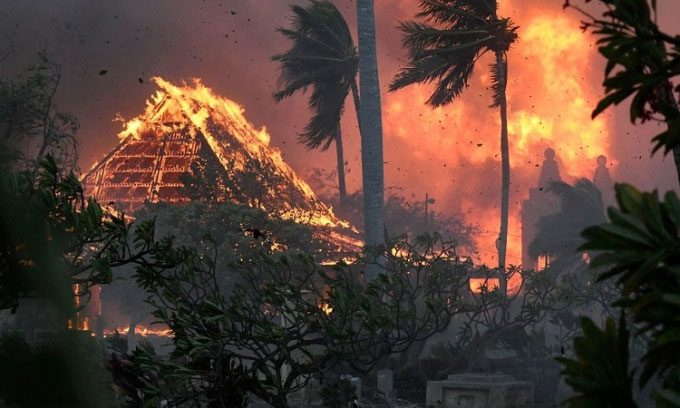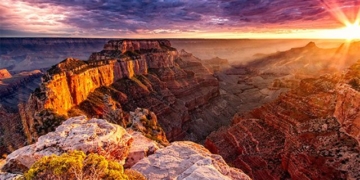Experts warn that residents returning after the massive fire on Maui Island will face potential dangers from the surrounding environment, including soil, water, and air.
People are returning to the ruins of the coastal town of Lahaina, Hawaii, and many other residential areas in Maui following one of the deadliest natural disasters in U.S. history. The wildfire has left many health risks for both humans and wildlife, according to Conversation.
As the fire spread through residential areas, as has been common in recent years, it incinerated structures containing treated wood, plastics, paints, and many other toxic household waste materials. These can burn vehicles and melt plastic water pipes. All of these items release particles and toxic gases. Airborne pollutants settle to the ground. When debris or dust is stirred up, toxic particles can mix into the air, making it easy for residents to inhale.

The fire destroyed many structures on Maui Island. (Photo: CNN).
Chemicals also contaminate water supplies. On August 11, 2023, Maui County issued a warning of “unsafe water” for the Lahaina and Upper Kula areas affected by the wildfire, advising residents to only use bottled water for drinking and cooking, rather than tap water due to the risk of harmful chemical contamination, according to Andrew J. Whelton, a professor of ecological, environmental, and civil engineering at Purdue University. Whelton and his colleagues are assisting the community in dealing with recovery from wildfires and other disasters, including the Marshall Fire in Boulder County, Colorado, and the Camp Fire that devastated Paradise, California. Lahaina and many other communities in Maui are facing similar risks.
Chemicals in Fire Debris
Residents returning to the heavily burned neighborhood are likely to be surrounded by risks. Some are quite visible, such as broken glass, nails, and destroyed natural gas tanks. Downed power lines may be live, and gas pipes could be leaking. The less obvious risk is that chemicals may have spread far beyond the burned area.
Black smoke from a fire indicates incomplete combustion, which can produce thousands of chemicals when wood and plastic are burned. Chemicals such as benzene, lead, asbestos, and polycyclic aromatic hydrocarbons (PAHs) are commonly found in ash, wastewater, and sometimes even in the water supply after a fire. Exposure to high levels of these chemicals can cause immediate symptoms such as dizziness, vomiting, headaches, rashes, and respiratory issues. For these reasons, residents, especially children and those with preexisting health conditions, need to avoid contact with chemicals. The Hawaii state health authorities recommend that residents wear shoes, masks, chemical-resistant gloves, and other protective gear when examining debris at their homes.
Safe Structures Still Pose Risks
Even homes that appear structurally safe contain pollutants that are unsafe for human health. Particles and toxic vapors can enter homes through cracks, doors, windows, and other entry points. Some pollutants settle on surfaces, while others penetrate fabrics, stick to walls, and enter air ducts. Typically, these buildings need to be cleaned or decontaminated by professional wildfire restoration companies. Cleaning surfaces and ducts, replacing air filters, and installing HEPA filters can be helpful.
Risks from Drinking Water and Soil
Drinking water is another significant concern after the urban fire. Wildfires can make pipes both inside and outside homes unsafe in several ways. Loss of water pressure can allow contaminants to enter the pipes. When plastic pipes heat up, they also degrade and can leak chemicals directly into the water.
Whelton and colleagues have noted that benzene levels exceeded hazardous limits for drinking water in several previous fires. PAHs are also present, according to their research findings. These chemicals pose an immediate health risk to water users, even if the water has no unusual odor. Comprehensive testing and sampling of water in buildings and larger water systems is crucial.
Outdoors, soil can also become contaminated during the fire. After debris cleanup, authorities need to test to ensure that the soil where residents garden and grow fruit trees is free from harmful chemicals.
Protecting Waterways and Aquatic Life
During firefighting and cleanup, when it rains, pollutants can wash into waterways and flow into the ocean. Lahaina, located along the western coastal region of Maui, is a favorite spot for sea turtles and many other wildlife. They are now at risk of exposure to contaminants from burned structures and wastewater.
Debris and sunken boats need to be cleared from the nearshore waters to protect coral reefs. Similarly, authorities must monitor water quality near lakes, rivers, and streams affected by wildfires. Communities can prevent wastewater from the cleanup process from flowing into waterways by placing pollution control barriers near storm drains, around properties, and near water bodies, helping to block contaminants from entering the ocean.
After the Marshall Fire destroyed about 1,200 structures in Colorado, the cleanup process generated 300,000 tons of waste. In Maui, debris needs to be transported off the island for disposal. The cleanup and recovery process may take years.


















































